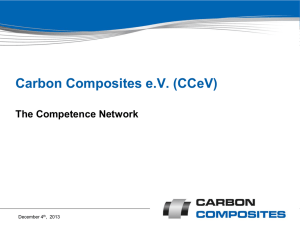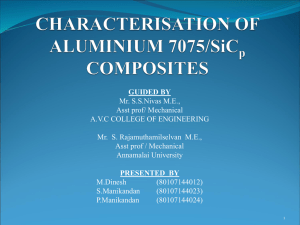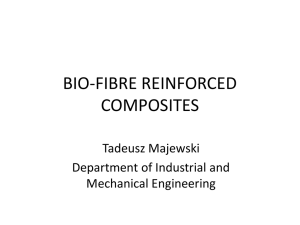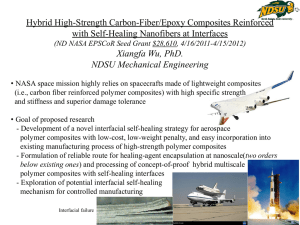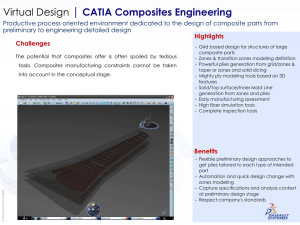Tensile Strength of Composits
advertisement
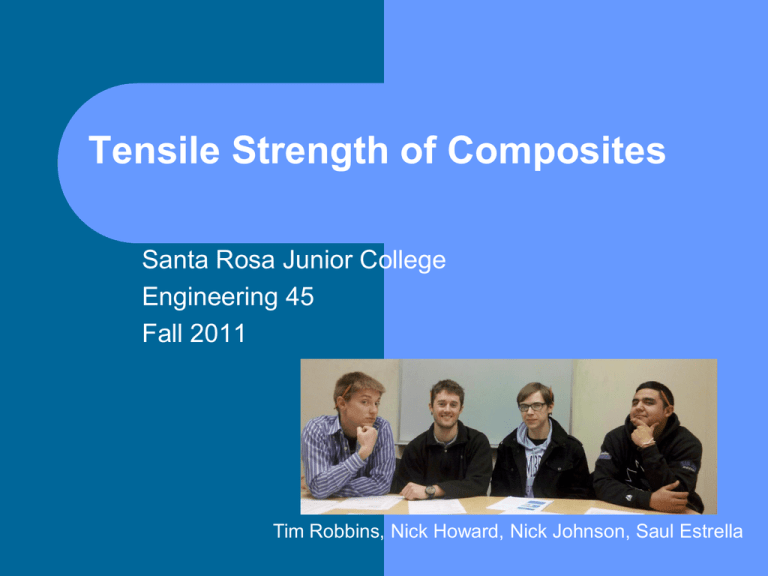
Tensile Strength of Composites Santa Rosa Junior College Engineering 45 Fall 2011 Tim Robbins, Nick Howard, Nick Johnson, Saul Estrella An Introduction to Composites Composites are defined as any material containing two or more substances which significantly displays the properties of all constituent parts in order to create a whole with a better combination of properties. Picture of ski composite (Courtesy: Materials Science and Engineering: An Introduction, 7th Edition) An Introduction to Composites • Much of the time, composites are made of two materials: • • • The matrix, which is the main and continuous material. The dispersed phase, which is suspending within the matrix and does not have to be continuous. There are three main categories of composite materials: • • • Particle-reinforced Fiber-reinforced Structural Particle-reinforced Composites • Particle-reinforced composites use small particulates as the dispersed phase Example: concrete, where the cement is the matrix and the sand/gravel forms the dispersed phase (Courtesy: Materials Science and Engineering: An Introduction, 7th Edition) Fiber-reinforced Composites • Fiber-reinforced composites use fibers with large strength to weight ratios as the dispersed phase Example: our samples containing carbon fiber fabric and fiberglass (dispersed phase) in an epoxy matrix Different possible fiber alignments (Courtesy: Materials Science and Engineering: An Introduction, 7th Edition) Structure Composites • Structure composites are made of layers of materials that have direction specific strength Example: skis, where layers of fiberglass are laminated together in order to give strength in more than one direction (Courtesy: Materials Science and Engineering: An Introduction, 7th Edition) Applications of Fiber-reinforced Composites • • • • • Aerospace components (wings, propellers, fuselages, etc.) Bicycles Racecars Helmets Surf Boards Boeing 787 composite fuselage. (Courtesy: Leo Watson) Our Experiment Objective: The purpose of our experiment was to find the stress-strain profiles for composites made of combinations of epoxy, carbon fiber fabric, and fiberglass. Our intent was to compare the results from two composite samples with that of a third purely epoxy control sample. Mold Creation We used the TAP Silicone RTV Mold Making System. This system is composed of liquid silicone which is activated by a tin catalyst. After mixing the two parts of the molding material together, we slowly and carefully poured it over the sample. After about a week, the mold was completely cured. Resin • • • Resin choice: • Polyester • Epoxy Tap Plastics: 1 to 1 General Purpose Epoxy Resin • Ideal for high strength applications • Minimal Shrinkage (<1%) Published Properties: (Courtesy: TAP Plastics) • Tensile Strength: 7,500 psi • Flexural Strength: 11,500psi • Hardness: 95 Rockwell R Samples We created three samples: Pure epoxy control Epoxy with S-2 woven fiberglass Epoxy with unidirectional carbon fiber fabric Testing We were unable to successfully test our samples in the tensile strength machine, so we instead did a three-point test. However, since we did not design our experiment around the three-point test, our results are largely qualitative. Three-Point Test The three-point test is done by placing the specimen across two supports and applying a compressive load in the middle. Due to our sample shape, the flexural strength is calculated according to the equation: (Courtesy: Materials Science and Engineering: An Introduction, 7th Edition) Ff = load at fracture point L = distance between supports R = radius of the specimen Control Sample Measured: σfs= 3853 psi (the number for L is taken as ~3 in.) σfs= 11,500 psi (from TAP technical specifications) Epoxy with Fiberglass Measured: σfs= 33015 psi (the number for L is taken as ~3 in.) Epoxy with Carbon Fiber Fabric Measured: σfs= 41130 psi (the number for L is taken as ~3 in.) Control Sample Image shows difference in thread sizes between control and carbon fiber sample after stretching control. Epoxy and Fiberglass Epoxy and Carbon Fiber Fabric Issues • • Our biggest issue was that our samples slipped out of the tensile machine due to not being completely cured. If we were to repeat this experiment, there are several things we could do to fix this problem: • • • Apply heat Not test samples prematurely Do a three-point test from the start Acknowledgments Dr. Younes Ataiiyan for all his guidance and advice, especially when things did not go according to plan. TAP Plastics for giving us student discounts and advice concerning material selections. Works Cited Callister, William. Materials Science and Engineering: An Introduction. 7th ed. York, PA: John Wiley & Sons, Inc., 2007. TAP Plastics. TAP Plastics, Inc., 2011. Web. 13 Dec. 2011. <http://www.tapplastics.com/>. Watson, Leo. Aviation Spectator. Aviation Spectator, 2011. Web. 13 Dec. 2011.

